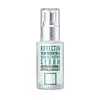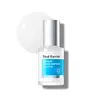What's inside
What's inside
 Key Ingredients
Key Ingredients

 Benefits
Benefits

 Concerns
Concerns

No concerns
 Ingredients Side-by-side
Ingredients Side-by-side

Water
Skin ConditioningPropanediol
SolventGlycerin
Humectant1,2-Hexanediol
Skin ConditioningNiacinamide
SmoothingIsononyl Isononanoate
EmollientAdenosine
Skin ConditioningAcetyl Hexapeptide-8
HumectantArginine
MaskingSodium Hyaluronate
HumectantMalachite Extract
AntioxidantAloe Barbadensis Leaf Juice
Skin ConditioningAcrylates/C10-30 Alkyl Acrylate Crosspolymer
Emulsion StabilisingPolyglyceryl-10 Laurate
Skin ConditioningPolyglyceryl-10 Myristate
Skin ConditioningCaprylic/Capric Triglyceride
MaskingAmmonium Acryloyldimethyltaurate/Vp Copolymer
Amodimethicone
Trehalose
HumectantPvp
Emulsion StabilisingButylene Glycol
HumectantEthylhexylglycerin
Skin ConditioningDisodium EDTA
Water, Propanediol, Glycerin, 1,2-Hexanediol, Niacinamide, Isononyl Isononanoate, Adenosine, Acetyl Hexapeptide-8, Arginine, Sodium Hyaluronate, Malachite Extract, Aloe Barbadensis Leaf Juice, Acrylates/C10-30 Alkyl Acrylate Crosspolymer, Polyglyceryl-10 Laurate, Polyglyceryl-10 Myristate, Caprylic/Capric Triglyceride, Ammonium Acryloyldimethyltaurate/Vp Copolymer, Amodimethicone, Trehalose, Pvp, Butylene Glycol, Ethylhexylglycerin, Disodium EDTA
Water
Skin ConditioningButylene Glycol
HumectantGlycerin
HumectantDipropylene Glycol
HumectantPolyglyceryl-10 Stearate
Skin ConditioningCaprylic/Capric Triglyceride
MaskingPanthenol
Skin ConditioningHydrogenated Lecithin
EmulsifyingLimnanthes Alba Seed Oil
Skin ConditioningVinyldimethicone
Squalane
EmollientSimmondsia Chinensis Seed Oil
EmollientPotassium Cetyl Phosphate
EmulsifyingMyristoyl/Palmitoyl Oxostearamide/Arachamide Mea
Skin ConditioningCeramide NP
Skin ConditioningBis-Capryloyloxypalmitamido Isopropanol
EmollientAdenosine
Skin ConditioningDipotassium Glycyrrhizate
HumectantMadecassoside
AntioxidantAllantoin
Skin ConditioningHydrolyzed Hyaluronic Acid
HumectantGlyceryl Stearate
EmollientPhytosteryl/Isostearyl/Cetyl/Stearyl/Behenyl Dimer Dilinoleate
Skin ConditioningSorbitan Stearate
EmulsifyingCetearyl Alcohol
EmollientPhytosterols
Skin ConditioningXanthan Gum
EmulsifyingPentylene Glycol
Skin ConditioningSodium Hyaluronate
HumectantHydroxypropyl Methylcellulose
Emulsion StabilisingSorbitan Laurate
EmulsifyingHydroxyethylcellulose
Emulsion StabilisingAcetyl Dipeptide-1 Cetyl Ester
Skin ConditioningBisabolol
MaskingGlyceryl Glucoside
HumectantGlucose
HumectantXylitylglucoside
HumectantAnhydroxylitol
HumectantXylitol
HumectantGlycosphingolipids
EmollientPhospholipids
Skin ConditioningMentha Viridis Leaf Oil
AstringentMentha Viridis Extract
MaskingCitrus Nobilis Peel Oil
MaskingPelargonium Graveolens Flower Oil
MaskingThymus Vulgaris Oil
MaskingEucalyptus Globulus Leaf Oil
PerfumingBarosma Betulina Leaf Extract
Perfuming1,2-Hexanediol
Skin ConditioningCaprylyl Glycol
EmollientCarbomer
Emulsion StabilisingDisodium EDTA
Arginine
MaskingGlyceryl Behenate
EmollientPolyglyceryl-6 Octastearate
EmulsifyingStearic Acid
CleansingWater, Butylene Glycol, Glycerin, Dipropylene Glycol, Polyglyceryl-10 Stearate, Caprylic/Capric Triglyceride, Panthenol, Hydrogenated Lecithin, Limnanthes Alba Seed Oil, Vinyldimethicone, Squalane, Simmondsia Chinensis Seed Oil, Potassium Cetyl Phosphate, Myristoyl/Palmitoyl Oxostearamide/Arachamide Mea, Ceramide NP, Bis-Capryloyloxypalmitamido Isopropanol, Adenosine, Dipotassium Glycyrrhizate, Madecassoside, Allantoin, Hydrolyzed Hyaluronic Acid, Glyceryl Stearate, Phytosteryl/Isostearyl/Cetyl/Stearyl/Behenyl Dimer Dilinoleate, Sorbitan Stearate, Cetearyl Alcohol, Phytosterols, Xanthan Gum, Pentylene Glycol, Sodium Hyaluronate, Hydroxypropyl Methylcellulose, Sorbitan Laurate, Hydroxyethylcellulose, Acetyl Dipeptide-1 Cetyl Ester, Bisabolol, Glyceryl Glucoside, Glucose, Xylitylglucoside, Anhydroxylitol, Xylitol, Glycosphingolipids, Phospholipids, Mentha Viridis Leaf Oil, Mentha Viridis Extract, Citrus Nobilis Peel Oil, Pelargonium Graveolens Flower Oil, Thymus Vulgaris Oil, Eucalyptus Globulus Leaf Oil, Barosma Betulina Leaf Extract, 1,2-Hexanediol, Caprylyl Glycol, Carbomer, Disodium EDTA, Arginine, Glyceryl Behenate, Polyglyceryl-6 Octastearate, Stearic Acid
 Reviews
Reviews

Ingredients Explained
These ingredients are found in both products.
Ingredients higher up in an ingredient list are typically present in a larger amount.
1,2-Hexanediol is a synthetic liquid and another multi-functional powerhouse.
It is a:
- Humectant, drawing moisture into the skin
- Emollient, helping to soften skin
- Solvent, dispersing and stabilizing formulas
- Preservative booster, enhancing the antimicrobial activity of other preservatives
Adenosine is in every living organism. It is one of four components in nucleic acids that helps store our DNA.
Adenosine has many benefits when used. These benefits include hydrating the skin, smoothing skin, and reducing wrinkles. Once applied, adenosine increases collagen production. It also helps with improving firmness and tissue repair.
Studies have found adenosine may also help with wound healing.
In skincare products, Adenosine is usually derived from yeast.
Learn more about AdenosineArginine is an amino acid that is important for human development. Your body uses is it to produce hair keratin and skin collagen.
As a cosmetic ingredient, Arginine has antioxidant properties and can also help repair damaged skin. This ingredient is derived either synthetically or from animals.
Arginine isn't fungal acne safe when used in the presence of other lipids (fats, fatty acids, oils, esters, etc). Oils and fats occur naturally within the skin, so take caution when using Arginine if you're prone to fungal acne.
Learn more about ArginineButylene Glycol (or BG) is used within cosmetic products for a few different reasons:
Overall, Butylene Glycol is a safe and well-rounded ingredient that works well with other ingredients.
Though this ingredient works well with most skin types, some people with sensitive skin may experience a reaction such as allergic rashes, closed comedones, or itchiness.
Learn more about Butylene GlycolThis ingredient is an emollient, solvent, and texture enhancer. It is considered a skin-softener by helping the skin prevent moisture loss.
It helps thicken a product's formula and makes it easier to spread by dissolving clumping compounds.
Caprylic Triglyceride is made by combining glycerin with coconut oil, forming a clear liquid.
While there is an assumption Caprylic Triglyceride can clog pores due to it being derived from coconut oil, there is no research supporting this.
Learn more about Caprylic/Capric TriglycerideDisodium EDTA plays a role in making products more stable by aiding other preservatives.
It is a chelating agent, meaning it neutralizes metal ions that may be found in a product.
Disodium EDTA is a salt of edetic acid and is found to be safe in cosmetic ingredients.
Learn more about Disodium EDTAGlycerin is already naturally found in your skin. It helps moisturize and protect your skin.
A study from 2016 found glycerin to be more effective as a humectant than AHAs and hyaluronic acid.
As a humectant, it helps the skin stay hydrated by pulling moisture to your skin. The low molecular weight of glycerin allows it to pull moisture into the deeper layers of your skin.
Hydrated skin improves your skin barrier; Your skin barrier helps protect against irritants and bacteria.
Glycerin has also been found to have antimicrobial and antiviral properties. Due to these properties, glycerin is often used in wound and burn treatments.
In cosmetics, glycerin is usually derived from plants such as soybean or palm. However, it can also be sourced from animals, such as tallow or animal fat.
This ingredient is organic, colorless, odorless, and non-toxic.
Glycerin is the name for this ingredient in American English. British English uses Glycerol/Glycerine.
Learn more about GlycerinSodium Hyaluronate is hyaluronic acid's salt form. It is commonly derived from the sodium salt of hyaluronic acid.
Like hyaluronic acid, it is great at holding water and acts as a humectant. This makes it a great skin hydrating ingredient.
Sodium Hyaluronate is naturally occurring in our bodies and is mostly found in eye fluid and joints.
These are some other common types of Hyaluronic Acid:
Learn more about Sodium HyaluronateWater. It's the most common cosmetic ingredient of all. You'll usually see it at the top of ingredient lists, meaning that it makes up the largest part of the product.
So why is it so popular? Water most often acts as a solvent - this means that it helps dissolve other ingredients into the formulation.
You'll also recognize water as that liquid we all need to stay alive. If you see this, drink a glass of water. Stay hydrated!
Learn more about Water